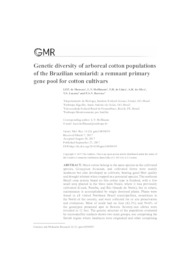Genetic diversity of arboreal cotton populations of the Brazilian semiarid: a remnant primary gene pool for cotton cultivars.
Genetic diversity of arboreal cotton populations of the Brazilian semiarid: a remnant primary gene pool for cotton cultivars.
Autoria: MENEZES, I. P. P. de; HOFFMANN, L. V.; LIMA, T. H. de; SILVA, A. R. da; LUCENA, V. S.; BARROSO, P. A. V.
Resumo: Mocó cotton belong to the same species as the cultivated species, Gossypium hirsutum, and cultivated forms were mainly landraces but also developed as cultivars, bearing good fiber quality and drought tolerant when cropped as a perennial species. The northeast Brazil crop system based on this cotton type is finished, with a few small area planted in the three main States, where it was previously cultivated (Ceará, Paraíba, and Rio Grande do Norte), but in others, maintenance is accomplished by single dooryard plants. Plants were found in all visited Northeast Brazil municipalities, sometimes in the North of the country, and were collected for ex situ preservation and evaluation. Most of seeds had no fuzz (62.2%) and 94.6% of the genotypes presented spot in flowers. Seventy-one alleles were revealed in 12 loci. The genetic structure of the population evaluated by microsatellite markers shows two main groups, one comprising the Seridó region where landraces were originated and other comprising the state of Ceará, where a specific breeding program was developed. Genotypes collected in North Brazil States as well as those collected in Bahia, Alagoas, and Sergipe grouped with those collected in Ceará. The Mantel correlogram indicates a significant (P < 0.05) correlation between genetic and geographical distances up to 77 km. The ex situ maintenance and agronomical evaluation are the main concerns for mocó, as the use of the agricultural interesting traits, possibly introgressed to other genotypes, is predicted. The in situ preservation is still of interest since there is more diversity there than in the collected plants and some should be continued due to use as medicinal plant.
Ano de publicação: 2017
Tipo de publicação: Artigo de periódico
Unidade: Embrapa Algodão
Palavras-chave: Alelo, Algodão, Alleles, Cotton, Fibra, Genetic diversity, Genotype, Genótipo, Germoplasma, Germplasm, Gossypium hirsutum
Observações
1 - Por padrão são exibidas publicações dos últimos 20 anos. Para encontrar publicações mais antigas, configure o filtro ano de publicação, colocando o ano a partir do qual você deseja encontrar publicações. O filtro está na coluna da esquerda na busca acima.
2 - Para ler algumas publicações da Embrapa (apenas as que estão em formato ePub), é necessário ter, no celular ou computador, um desses softwares gratuitos. Sistemas Android: Google Play Livros; IOS: iBooks; Windows e Linux: software Calibre.
Acesse outras publicações
Acesse a Base de Dados da Pesquisa Agropecuária (BDPA) para consultar o acervo completo das bibliotecas da Embrapa.

